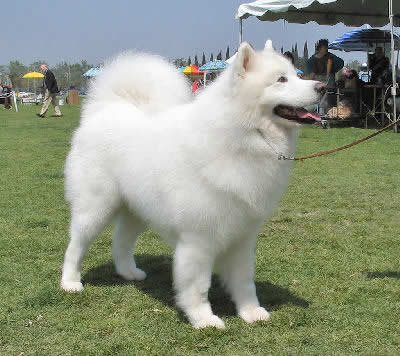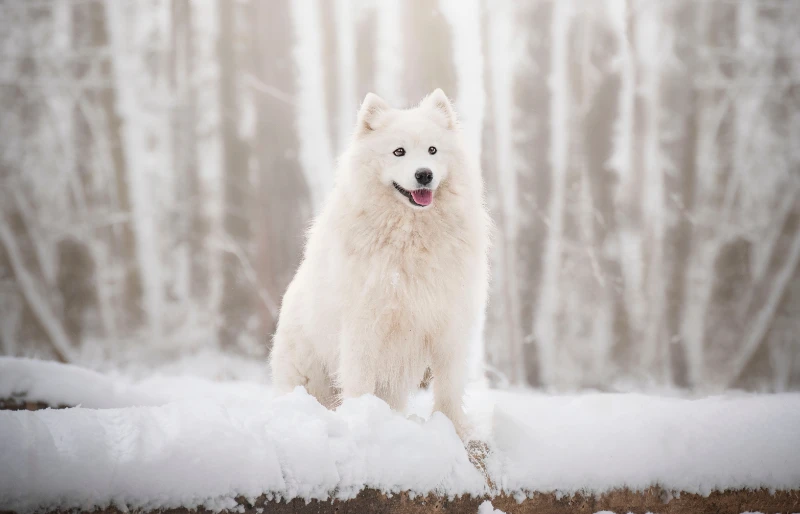
The pretty Samoyed has thick fur and a strong built, perfect for a working dog in cold country!
The Samoyed dog is favored as a companion to hunters and fishermen. With a history dating back over 3000 years, this working dog breed was developed by the Samoyede people of Siberia. It has been used as a sled dog, a reindeer herder, and a guard dog, as well as a companion. This medium sized dog is muscular and strong, with a heavy weather resistant double coat for warmth. Its demeanor is bright and alert, and it likes to be active and busy..
The Samoyed has a smiling expression to its face that matches its easygoing, friendly attitude. It is friendly to family and strangers alike, but will usually bark to announce the arrival of a stranger. This breed is loyal, playful and intelligent. When choosing a Samoyed, check for kidney disease, hip dysplasia, eye problems, and diabetes.
- Kingdom: Animalia
- Phylum: Chordata
- Class: Mammalia
- Order: Carnivora
- Family: Canidae
- Genus: Canis
- Species: lupus familiaris
Common Name(s)
Samoyed, Bjelkier, Samoyedskaya, Sammy
Breed Type
The dutiful, loyal Samoyed is a working breed. Traditionally used as sled dogs and reindeer herders, this breed is best suited to cool climates.
Background
The Samoyed breed goes back 3,000 years or more. Originally from Siberia, the Samoyed was a helper and companion to ancient hunters and fishermen. A Samoyed was the lead dog on the first expedition to the South Pole. The breed came to the United States in 1906.
Description
The Samoyed is a muscular dog with a beautiful thick coat. White is the preferred color, but biscuit, yellow, and cream are also accepted. The Samoyed has a wedge-shaped head with dark eyes and a black or brown nose. Its mid-sized ears are triangular, erect, and slightly rounded at the tip. The tail is curled up over the back. Males measure 21-23 �½ inches and weigh 45-65 pounds. Females are 19-21 inches tall and weigh 35-50 pounds.
Care and Feeding
The Samoyed’s diet should include horse meat, poultry, fish, wheat and potatoes. Adults also enjoy, and can benefit from, tuna canned in water. Frequent brushing is required to keep the Samoyed’s coat looking good. This is especially important when the dog blows its coat. Bathing should be done only as needed, and it is important to dry the coat completely with forced air to prevent skin problems.
Samoyeds need yearly checkups to stay healthy. Vaccinations are due as follows:
- 6-8 weeks: Distemper, Leptospirosis, Hepatitis, Parainfluenza, Parvo, and Corona virus (DHLPPC)
- 10-12 weeks: Second DHLPPC
- 14-16 weeks: Third DHLPPC and rabies
- Annually: DHLPPC and rabies booster
Samoyeds shed heavily at times. Regular vacuuming is essential during these times if the dog is kept indoors.
Housing Your Dog
Samoyeds can live indoors or out. A small yard is adequate for this breed. It is important to protect your Samoyed from very hot temperatures.
Social Behaviors
Samoyeds get along well with children and strangers. They enjoy the company of other dogs, especially fellow Samoyeds. They may not get along with smaller pets.
Handling and Training
The Samoyed is rather strong-willed when it comes to training. It is important to start young and be firm.
Activities
Samoyeds need daily walks, but it is important to make sure that they do not overheat. They also like to play off-leash regularly.
Breeding/Reproduction
When selecting a mate for your Samoyed, check bloodlines for hip dysplasia, diabetes, and PRA. Samoyed Hereditary Gluomerulopathy, a kidney disease, is prevalent in the breed, and there is currently no screening test available. Finding a mate that is a product of responsible breeding can help avoid this problem.
Common Health Problems
Eye problems are often found in Samoyeds, as is diabetes. Hip dysplasia is also prevalent.
Availability
Samoyeds are hardtop find in many areas. Breeders can be located online. Prices average between $400 and $1,000.
References
- Liz Palika, The Howell Book of Dogs: The Definitive Reference to 300 Breeds and Varieties , Howell Book House, 2007
- American Kennel Club, The Complete Dog Book: 20th Edition (Complete Dog Book) , Ballantine Books, 2006
- Kristin Mehus-Roe, The Original Dog Bible: The Definitive Source to All Things Dog, BowTie Press, 2005
- Samoyed, Copyright Dog Breed Info Center
- Samoyed (dog), Wikipedia
- Samoyed Puppies for Sale, Copyright PuppyFind.com, LLC
Featured Image Credit: Monika Hodanova, Shutterstock
